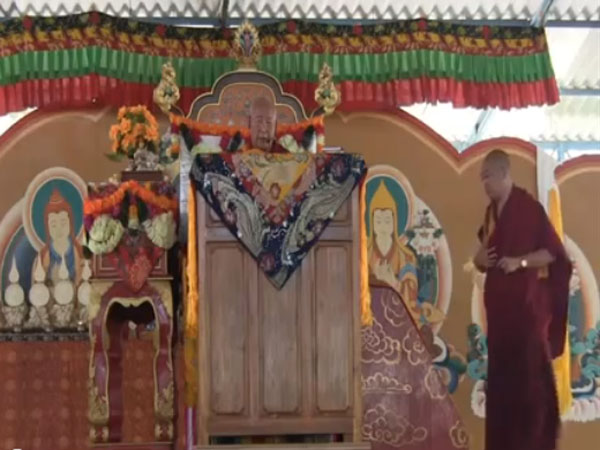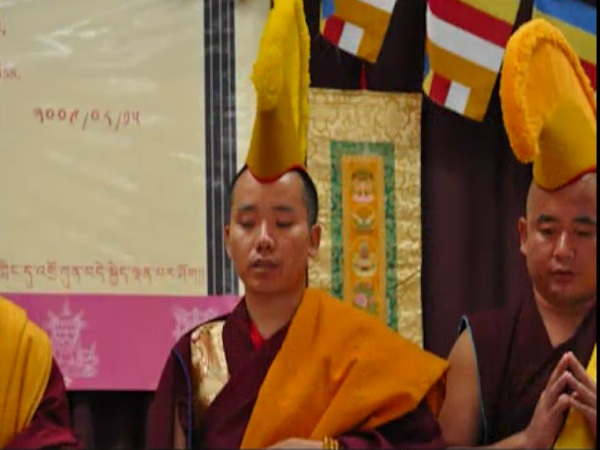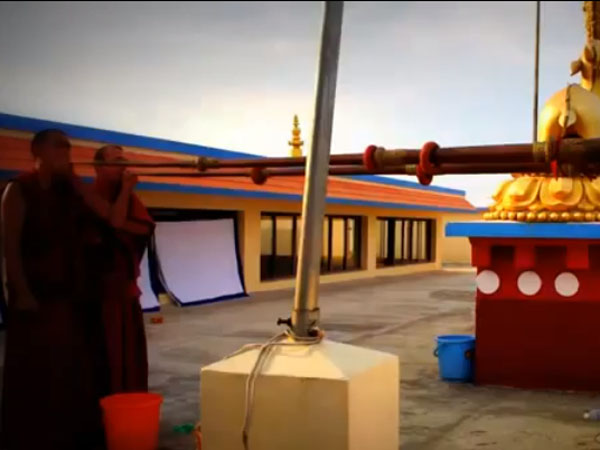FEATURES
| THE PEOPLE’S PRINCESS – YABSHI PAN RINZINWANGMO | | Print | |
|
Can she change her country?  The child of Tibet's most religious figure Steven Seagal: The most important man in her life
YABSHI PAN RINZINWANGMO, a 20-year-old political science student at a university in Washington USA, likes to be called Renji. Her Chinese mother uses the title “princess”. The Communist Chinese government not only permits the royal honorific but endorses it. Readers' Comments
Renji’s father was the 10th Panchen Lama, an incarnation in a line of Lamas who became powerful in Tibet in the 17th Century. The Dalai Lama rules as a king, but the Panchen Lama, who has no formal political role, has greater spiritual authority for some. The spiritual brothers are both bodhisattvas – highly evolved beings who’ve chosen to return to earth to help others find enlightenment. Renji has never lived in Tibet, but in 1990, a year after her father died at his monastery in Tibet, her mother took her to the old Tibetan province of Kham, which has been largely absorbed by the Chinese province of Sichuan. Hundreds of people set up tents by the roadside waiting for a glimpse. “They told me there were people lining the road for miles,” Renji says, in American-accented English. “Thousands of people all wanting to touch me. I was only seven.” There’s no religious reason Renji should attract devotion. Her father’s position as an incarnation of the Buddha isn’t hereditary, but many Tibetans still revere her. “They think I’m some kind of Buddha statue,” she says. “They take my hand and put it on their heads as a blessing. I can’t complain because it makes them happy to see and touch me. I only ask my bodyguards to stop them when they lift my skirt to touch my feet.”
The child of Tibet's most religious figure Initially, Gonpo Tseten was not a favoured candidate. But the three boys who were considered more likely to be the reincarnation had died. So in 1949 the Kuomintang government, in one of its last acts before being overthrown by Chairman Mao Zedong, declared 11-year-old Gonpo Tseten the 10th Panchen Lama. At the age of 14, Renji’s father settled into the Tashilhunpo monastery, the traditional seat of the Panchen Lamas. Although Chairman Mao promised that central Tibet would be exempt from socialist changes, in eastern Tibet the Communist Party set about changing traditional society. The Panchen Lama’s entourage had been pro-Chinese in the beginning, but how much the Panchen Lama himself supported the Party remains a matter of dispute. After 1959, when the Dalai Lama left the country, the Panchen Lama was the most senior religious figure left in Tibet. In the spring of 1962, he submitted a report detailing his view of the consequence of Chinese policies in Tibet. The Panchen Lama thought he’d made a reasoned contribution to the Party’s rule, but some Communist leaders saw him as a “reactionary” enemy. By 1968, the Panchen Lama had disappeared into solitary confinement in Beijing. For years he was thought to be dead. When he was released in 1977, the Tibet he’d known was gone. His old life was over, so he decided to build a new one. In 1979, at the age of 40, he did what no other Panchen Lama had ever done – he got married. His wife, Li Jie, was the daughter of a former general in the Kuomintang Army. Both families disapproved – Li Jie’s father refused to speak to her until the wedding day, while the Panchen Lama’s mother was never fully reconciled to the match. Renji was born in 1983, and as Deng Xiaoping steered China through the 1980s, the family joined the privileged inner circles in Beijing. There were toys and pretty dresses, birthday parties, picnics and holidays to Tibet. Then in 1989, the Panchen Lama died. The status of his widow and child was ambiguous. By this time, Li Jie had taken a Tibetan name and dressed in Tibetan clothes. She’d learnt the language and became a Buddhist. But widows don’t figure in Tibet’s celibate religious orders. Traditionally, a deceased Lama’s property is kept in trust for his next incarnation. But as her husband enjoyed wealth at the end of his life, Li Jie insisted on provisions for herself and her child. The dispute over the Panchen Lama’s property dragged for years. The Chinese government wanted Li Jie and Renji to move out of the villa built by the Panchen Lama in Beijing. At one stage, power supply was even cut off. But finally, a settlement was reached that left Li Jie comfortably off. At the same time, the search for the 11th Panchen Lama became a contest over who had the right to recognise him; the exiled Dalai Lama or the Chinese government. In May 1995, the Dalai Lama announced that a suitable boy was found in a remote central Tibet district. Days later, there were rumours in Lhasa that the boy and his family had been taken into custody by security forces. In November, a ceremony was held in Lhasa, attended by government officials, at which another boy, whose parents were both reportedly part of the Communist Party, was declared the real reincarnation of the Panchen Lama. The “Chinese Panchen Lama” was installed in a heavily guarded villa on the outskirts of Beijing. The Dalai Lama’s selection hasn’t been seen since. The following year, Renji’s mother decided to send her abroad, “To learn English and meet more people,” as Renji explains. Southwestern Academy, the boarding school she attended, is a 20-minute drive from downtown Los Angeles. The headmaster says Renji wasn’t studious and adds that she loved pop music and shopping, and had a taste for clothes by Prada. She was close to a boy from Beijing whom the school eventually expelled for smoking marijuana. She herself was never a problem, although she went through a worrying phase of loving motorcycles. This passed, but Renji still loves cars. “My dad did too,” she says, “I think I got it from him.” Many of Renji’s fellow high-school students are children of China’s new rich. One teacher says the students once had a discussion about the relative merits of flying first class or using your own jet. When another teacher proposed the essay topic ‘What would I do with a million dollars?’ the exercise fell flat because the students agreed a million dollars couldn’t go far these days. But if other students could enjoy spending their parents’ money far from home, Renji is too important a figure to be left alone. For some representatives of the Tibetan government in exile, she’s a potential bridge between them and the Chinese. For the Chinese, she is someone who could be politically helpful in Tibet. And for Westerners, Renji is a precious trophy to be guarded, both for her ancestry and for her potential to play an important role in Tibetan politics.
Steven Seagal: The most important man in her life  Most weekends during her time at high school, a stretch limo would arrive to take Renji to the home of the actor Steven Seagal, who’s visited the Dalai Lama in exile in India. He’s also been recognised as the reincarnation of a Lama by a Tibetan guru. As Renji’s protector in the US, he is controversial, to say the least. The actor explains how he came to have charge of the Panchen Lama’s daughter. “When Renji was eight or nine, we got word that she wasn’t safe. The Tibetan government in exile has its own spies. So she had to get out. It wasn’t going to be a kidnapping but an amiable trade-off. Her mother was to remain in China. When Renji was 10 or 11, we got word this was going to happen. I spoke with my friends there, and they said I was one of the few people who could protect her… be her father figure, her guardian.” Steven’s account differs from that of other insiders, and Renji herself says she never felt in danger in Beijing. But she clearly feels safe with Steven. “This is my home,” she says, “He was always there for me. My mother and Steven Seagal are the most important people in my life.” “The danger for Renji is now getting in with the wrong people,” Steven says. “She has a pure heart. I just tell her, I’m always here for her.” As a student in the US, Renji hung out, partied, shopped, learnt to surf. Back home in Beijing, during the holidays, she became a noted tennis player. But in 2002, Li Jie decided Renji should visit Tibet. The plan was for her to spend time on religious studies and learn the Tibetan language from teachers at the Tashilhunpo monastery. She was to pay respects to her father’s body each morning, then spend the day studying in a room on the second floor of the stupa where her father is interred. But crowds gathered within a day of her arrival. “They stood outside, waiting for me,” she says, “After two days, the police figured out what to do. They lined them all up. Every hour I’d come out and go down the line. I’d go back and study, and then, at the end of the hour, go down the line again.” The crowds grew bigger each day and local authorities began to worry about things getting out of control. Then the “Chinese Panchen Lama” arrived in Tibet. He was approaching his 12th birthday. The boy now lives in Beijing and his visits to Tibet are rare and heavily policed. “My plan was to stay close to my father,” Renji says. But she was asked to travel to Lhasa, where a meeting between her and the boy had been set up. The meeting was short, Renji says. “There were 20 or 30 people, all officials, his people. I walked in, said, ‘Hello, how are you?’ Then we exchanged khatags (white ceremonial scarves, used as greetings at important occasions).” But she did not prostrate herself before him. Many would have seen a prostration as an affirmation that he is a true incarnation of the Panchen Lama. But Renji doesn’t see it as an issue. “My father gave me permission not to prostrate to him. If he is my father’s reincarnation, I don’t have to prostrate to him.” Renji has a standard answer when asked about her future. She says she wants to help the people of Tibet. She wants to be a member of the National People’s Congress, like her father. “It’s power. You need power to do things.” Gaining power involves negotiations between several competing interests. Says Tibetan historian Tsering Shakyays, “The Chinese have recognised their Panchen Lama and they can’t allow Renji to undermine him. On the other hand, the Dalai Lama is outside Tibet, and there is nobody like the old Panchen Lama in the country. There is opportunity, and perhaps Renji has it in her to grasp it.” So has Renji ever been tempted to choose an ordinary life – a job, marriage, kids? “I can’t,” she says, “Well, I could, but I can’t. It’s my duty. It’s who I am.”
|
OTHER FEATURES
- GADEN KACHOE SHING, USA
- TUGS BAYASGALANT NUNNERY
- TRIJANG CHOCKTRUL RINPOCHE LEADS VAJRA YOGINI FIRE PUJA
- GESHE YESHE WANGCHUK AND HIS HEART DISCIPLE, TRICHEN LAMA
- SUPPORTING THE GROWTH OF DORJE SHUGDEN IN SOUTH AFRICA









